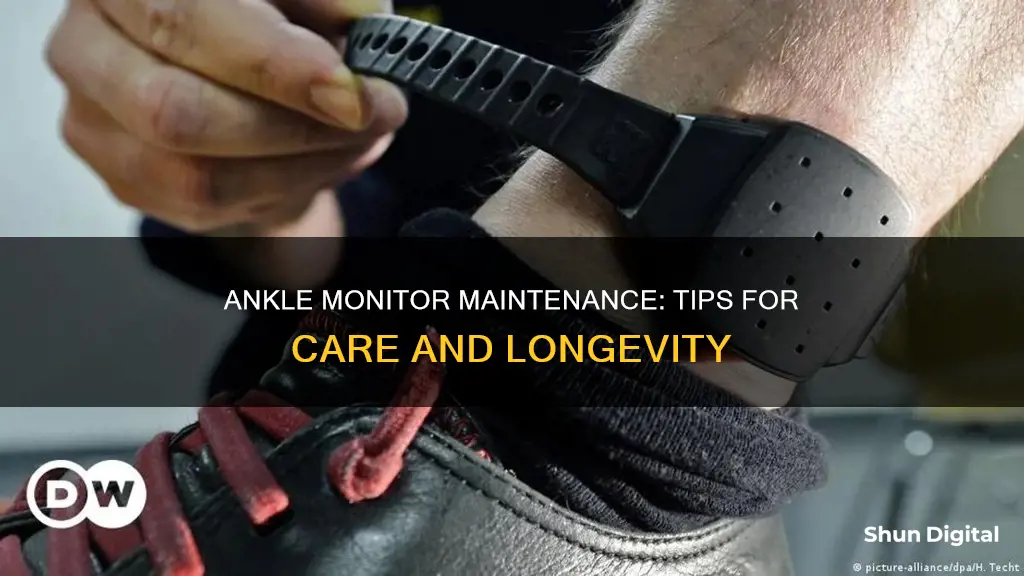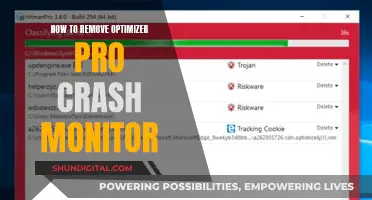
Ankle monitors are used to track the movements of individuals who have been placed under house arrest, are awaiting trial, or are serving probation or parole. They are often used as an alternative to jail time for low-risk, non-violent offenders, or as a condition for bail or probation. These devices can monitor the presence or absence of the wearer from an exact location and can also detect alcohol consumption by testing sweat. While they are designed to be unobtrusive, they can cause discomfort and skin irritation. Wearers are advised to wear loose-fitting clothing and use lotion to alleviate these issues. Additionally, they must ensure the monitor is charged daily to avoid a loss of signal, which can result in legal consequences.
| Characteristics | Values |
|---|---|
| Purpose | To ensure the wearer stays within boundaries set by the court |
| Type of crime | Nonviolent crimes, including DUI, DWI, and immigration cases |
| Who wears them | People awaiting trial, convicted offenders on parole or probation, and those facing immigration proceedings |
| Cost | $5-$30 a day; setup charges can range from $100-$200 |
| Installation | Must be installed by a company |
| GPS tracking | Tracks wearer's location and sends alerts if they go outside designated area |
| RF tracking | Detects presence or absence of wearer from an exact location |
| Alcohol monitoring | SCRAM bracelet detects alcohol in wearer's sweat |
| Charging | Must be charged daily; power outages can affect battery life |
| Landline requirement | Required in some states to track movement |
| Comfort | Can cause skin irritation |
| Medical procedures | May interfere with MRI's, x-rays, mammograms, and CT scans |
| Tampering | All ankle monitors have a way to detect if the device has been tampered with |
What You'll Learn

Keep the device charged to avoid a loss of signal
Keeping an ankle monitor charged is essential to ensure uninterrupted signal transmission and avoid potential violations. While the exact charging requirements may vary across different models, some general guidelines can be provided.
Firstly, it is crucial to follow the specific charging instructions provided by the monitoring company or the relevant authority. These instructions should outline the frequency and duration of charging needed to maintain the device's power. For example, a GPS tracker may require charging for approximately 2 hours daily, as seen in some cases.
The charging process typically involves using a cordless charger that can be attached directly to the base of the tracker. This allows for convenient charging without restricting movement within the home environment. It is important to ensure the charger is correctly connected to the tracker to avoid any interruptions in power.
In addition to regular charging, it is also important to monitor the battery life of the device. Ankle monitors are usually equipped with features to notify the wearer of low battery levels, such as vibrating alerts. Staying vigilant about these alerts and promptly charging the device can help prevent unexpected power loss.
Furthermore, it is worth noting that tampering with the charging process or failing to adhere to the specified charging rules can result in legal consequences. Monitoring authorities can track the charging history of the device, and violations may lead to additional penalties or even a return to jail. Therefore, it is crucial to take the charging requirements seriously and maintain the device's power to avoid any issues.
By following the provided charging instructions, staying vigilant about battery life, and promptly addressing any charging-related issues, individuals can effectively maintain the charge of their ankle monitors and avoid signal loss. This helps ensure compliance with the conditions of their sentence or release and reduces the risk of unintended violations.
OLED Monitor Buying Guide: Is It Worth It?
You may want to see also

Wear loose-fitting clothing to avoid chafing and skin irritation
If you are required to wear an ankle monitor, it is important to wear loose-fitting clothing to prevent chafing and skin irritation. This is one of the ways to make wearing an ankle monitor more comfortable and less painful. The ankle monitor should not be too tight or constricting, as this can lead to skin irritation and chafing.
Loose-fitting clothing is a simple yet effective way to prevent discomfort and allow for freedom of movement. It is important to choose clothing that does not restrict your range of motion and allows the monitor to sit comfortably on your ankle. This is especially important if you need to wear the monitor for an extended period.
The type of fabric you choose can also make a difference. Opting for breathable fabrics such as cotton or linen can help keep the skin under the monitor dry and comfortable. It is also recommended to apply lotion to the skin around the monitor to prevent dryness and irritation.
Additionally, it is important to ensure that the monitor is fitted correctly. It should be snug enough to stay in place but not too tight, allowing for some movement of the ankle. A monitor that is too tight can restrict blood flow and cause discomfort, while a monitor that is too loose can slip off and trigger a tamper alert.
By following these guidelines and choosing loose-fitting clothing, you can help ensure that your experience with an ankle monitor is as comfortable and irritation-free as possible.
Kia Sportage: Blind Spot Monitoring Feature Explained
You may want to see also

Use lotion to prevent skin drying
Keeping Skin Moisturised While Wearing an Ankle Monitor
Ankle monitors can be uncomfortable and cause skin irritation. To prevent this, it is important to keep the skin moisturised.
Lotions and creams can be applied to the skin around the monitor to prevent it from drying out. This will also help with any irritation caused by the anklet. It is best to use a mild, unscented lotion to avoid skin reactions. Fragranced products may irritate the skin further, especially if the area is already sore.
It is also important to ensure the monitor is not too tight. It should be snug but with enough room to move your ankle freely. If the monitor is too tight, this may cause further skin irritation and discomfort. If you are experiencing skin irritation, it is recommended to wash the area under the band with soap and water daily to prevent sores from forming.
If you are unable to keep the skin moisturised and irritation occurs, it is important to contact the relevant authority to seek advice and guidance.
Removing Backstand from Curved Monitors: A Step-by-Step Guide
You may want to see also

Check the fit to ensure the monitor is snug but not too tight
Ensuring that your ankle monitor is snug but not too tight is crucial for your comfort and to prevent the device from slipping off. Here are some detailed instructions and considerations to help you achieve the ideal fit:
Choose the Right Size Monitor
The first step to ensuring a snug fit is to select a monitor that is the appropriate size for your ankle. If the monitor is too large or too small, it will rub against your skin and cause irritation. It is important to choose a monitor that fits your ankle comfortably, allowing you to move freely without the device sliding around.
Adjust the Straps
The straps of the ankle monitor should be snug but not too tight. You should be able to fit one or two fingers between the monitor and your skin. Check the tightness of the straps throughout the day and adjust as needed. This will help improve your comfort and prevent the monitor from cutting off circulation or causing pain in your ankle.
Use Padding
If you find that the monitor is still too loose and tends to slide around, you can try using padding or a wrap. Soft padding, such as foam or cloth, can be placed between your skin and the monitor to provide a more secure fit. Additionally, an ace bandage can be wrapped around the ankle monitor to reduce friction and irritation.
Keep the Monitor in Place with Moleskin
Moleskin, a soft adhesive padding available at most drugstores, can be cut into small pieces and attached to your skin before putting on the ankle monitor. This will help keep the monitor in place and prevent it from slipping, ensuring it remains snug on your ankle.
Take Breaks
If you are experiencing discomfort due to the fit of the monitor, it is important to take breaks whenever possible. Removing the monitor for a short period each day will allow your skin to breathe and give you some relief from any irritation or tightness.
Remember to consult with your supervising officer or agency before making any significant adjustments to the fit of your ankle monitor. They can provide guidance and ensure that any modifications are within the permitted guidelines.
Is Your iPad Being Monitored? Here's How to Find Out
You may want to see also

Use moleskin to prevent the monitor from slipping
Moleskin is a soft adhesive padding that can be used to keep an ankle monitor in place. It is a thin but heavy cotton fabric that is soft on one side and has a sticky adhesive backing on the other.
To prevent an ankle monitor from slipping, you can cut a small piece of moleskin and attach it to your skin before putting on the anklet. This will help keep the monitor in place and prevent it from slipping.
Moleskin is often used to prevent blisters when wearing shoes, and it can be found at most drugstores or on Amazon. When using moleskin, it is important to ensure that your skin is clean and dry before attaching it.
By using moleskin, you can improve the fit of the ankle monitor and make it more comfortable to wear. It is a simple and effective way to keep the monitor in place and prevent any slipping or movement.
In addition to using moleskin, there are also other ways to make wearing an ankle monitor more comfortable. It is recommended to wear loose-fitting clothing and avoid anything too tight or constricting around the monitor, as this can lead to chafing and skin irritation. Applying lotion to the skin around the monitor can also help keep it moisturized and prevent irritation.
Setting Up a Monitor with Nvidia Quadro: Easy Steps
You may want to see also
Frequently asked questions
The cost of ankle monitors varies across the US and depends on the state and the company providing the device. The daily fees can range from $3 to $35.
No, ankle monitors can be uncomfortable and have been known to cause skin irritation.
Yes, but it is advised to wear loose-fitting clothing to avoid chafing and skin irritation.
Ensure the monitor is snug but not too tight. You can also use moleskin, a soft adhesive padding, between the monitor and your skin to keep it in place.
All ankle monitors have a way to tell if the device has been tampered with. If you attempt to remove the monitor, it will alert the monitoring centre and law enforcement.







